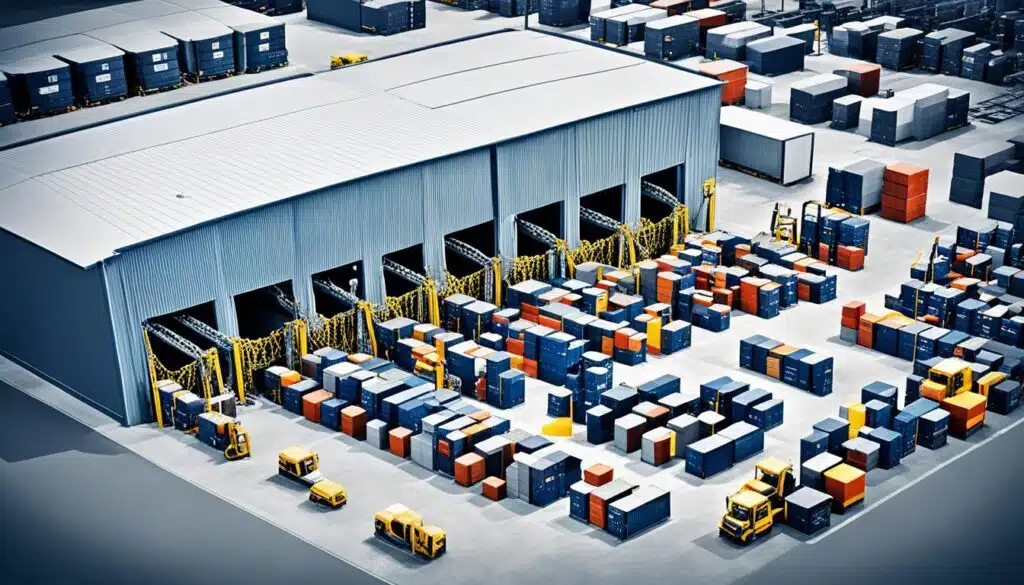Property insurance for warehouse is a crucial aspect of risk management in the storage industry. It provides coverage and protection against the various risks that can arise in warehouse operations, including damage, loss, and liability concerns. To effectively navigate the complexities of property insurance for warehouses, it is essential to understand the coverage agreements, the legal liability of warehouse operators, and the significance of contractual terms and warehouse receipts.
Key Takeaways:
- Property insurance for warehouses is vital for managing risks in storage operations.
- Understanding coverage agreements and contractual terms is crucial for proper protection.
- Warehouse operators have specific legal liability responsibilities.
- Warehouse receipts and contracts define limits of liability for warehouses.
- Complex claims and risk management efforts require expertise and proactive measures.
Warehouse Legal Liability Coverage Agreement
Warehouse legal liability (WHLL) is a casualty coverage that specifically addresses the legal responsibility of a warehouse operator or bailee. It is triggered when the insured is liable for physical loss or damage to stored property. While WHLL may seem similar to first-party property coverage, it differs in that it only responds when the insured is legally liable for the loss. Understanding the coverage agreement of WHLL policies and differentiating it from first-party coverage is crucial in ensuring proper protection.
When it comes to warehouse legal liability coverage, it is important to be aware of the specific terms and conditions outlined in the agreement. These agreements define the scope of coverage and outline the responsibilities of both the insured and the insurer. By fully understanding the coverage agreement, warehouse operators can ensure they have appropriate protection for their business and assets.
One key aspect to consider in WHLL coverage agreements is the determination of legal liability. The policy may outline the criteria that need to be met for the insured to be considered legally liable for any loss or damage. This may include factors such as negligence or breach of contract. Understanding these criteria can help warehouse operators mitigate their risk exposure and take necessary precautions to avoid potential losses.
In addition, WHLL coverage agreements may specify the types of property covered under the policy. This can include goods stored in the warehouse, equipment used in the storage process, and even the physical warehouse structure itself. By clearly identifying the covered property, both the insured and the insurer can be certain of the extent of the coverage and avoid any disputes in the event of a claim.
A well-crafted WHLL coverage agreement should also outline the limits of liability. This refers to the maximum amount that the insurer will pay in the event of a covered loss or damage. It is important for warehouse operators to carefully assess their risk exposure and ensure that the coverage limits align with the value of the property being stored. By setting appropriate limits of liability, warehouse operators can avoid being underinsured or overpaying for coverage they do not need.
Key Elements of a Warehouse Legal Liability Coverage Agreement
Here are some of the key elements that are typically included in a warehouse legal liability coverage agreement:
- Definition of covered property
- Criteria for determining legal liability
- Limits of liability
- Exclusions and limitations
- Claims process and procedures
- Policy duration and renewal terms
By carefully reviewing and understanding these elements, warehouse operators can make informed decisions when selecting a WHLL policy and ensure that their legal liability is adequately covered.
Understanding the coverage agreement of WHLL policies is crucial in ensuring proper protection for warehouse operators.
It is also important to note that while WHLL coverage provides valuable protection, it may not cover all types of losses or damages. Warehouse operators should carefully consider their specific risk exposures and consider additional coverage options as needed.
Overall, having a clear understanding of the coverage agreement in a warehouse legal liability policy is essential for warehouse operators. It allows them to assess their risk exposure, select the appropriate coverage, and ensure that they are adequately protected in the event of a loss or damage.
Legal Liability of Warehouse Operators
Warehouse operators bear legal liability for the property under their care. However, the standard of care expected from them is relatively lenient, requiring them to demonstrate reasonable actions in protecting the property.
The extent of the warehouse operator’s liability is determined by the terms of the storage contract or service agreement. This includes the warehouse receipt, storage contract, or service agreement, which outlines the rights and responsibilities of both parties.
It’s important for insurance professionals and buyers to understand the legal liability of warehouse operators and its implications for coverage. Let’s take a closer look at the factors that influence their liability under the law:
- Standard of Care: Warehouse operators must meet a reasonable standard of care in protecting the property under their responsibility. This entails implementing appropriate security measures, conducting regular inspections, and properly maintaining the premises to prevent potential damage or loss.
- Storage Contract: The storage contract or service agreement between the warehouse operator and the owner of the stored property defines the extent of the warehouse operator’s liability. It may include clauses specifying the types of losses covered and any limitations on liability.
- Warehouse Receipt: A warehouse receipt is a legal document issued by the warehouse operator that acknowledges receipt of the property and establishes the terms of storage. It often includes details about the limitations of liability and may be subject to negotiation between the parties involved.
“Warehouse operators must exercise a reasonable standard of care in protecting the property under their responsibility.”
Understanding the legal liability of warehouse operators is crucial for insurance professionals and buyers to ensure adequate coverage. By comprehending the standard of care and the terms within the storage contract or service agreement, stakeholders can assess the risks involved and take appropriate measures to mitigate them.
Comparison of Warehouse Operators’ Liability
| Legal Liability Factors | Warehouse Operators | Implications |
|---|---|---|
| Standard of Care | Relatively lenient, requiring reasonable actions to protect the property | Lower burden of proof for the warehouse operators |
| Storage Contract | Terms outlined in the contract determine the extent of liability | Defines the insurance coverage and potential limitations |
| Warehouse Receipt | Specifies the limitations of liability | Provides transparency on the extent of potential coverage |
The legal liability of warehouse operators is a critical aspect of risk management and insurance coverage. By understanding the unique responsibilities and limitations associated with warehouse operations, insurance professionals and buyers can ensure they have the appropriate coverage to protect their assets.
Warehouse Receipts and Contracts
Warehouse receipts and contracts are essential elements that define the legal responsibility and limits of liability for warehouse operators. These documents not only establish the terms and conditions of the storage agreement but also provide crucial information regarding the extent of coverage and the responsibilities of both the warehouse operator and the customer.
Warehouse receipts, in particular, serve as legally binding documents that outline the details of the storage arrangement. They typically include information such as the description of the stored goods, storage fees, and the limitations of liability imposed by the warehouse operator. These limitations can be based on factors like weight, monthly storing charges, or a specific value multiplied by the merchandise.
Warehouse receipts not only serve as proof of ownership but also serve as a means of establishing the legal responsibility of the warehouse operator. They outline the limits of liability that the operator has agreed to assume, providing clarity and transparency for all parties involved in the storage arrangement.
On the other hand, contracts can stipulate additional liabilities beyond what the warehouse operator would normally be responsible for. These additional liabilities are often negotiated and agreed upon between the warehouse operator and the customer, and they can impact the coverage provided by insurance policies.
Insurance policies that cover warehouse operations may require specific approval for contractual liability, and underwriting considerations may come into play. It is important for both warehouse operators and customers to thoroughly understand the terms of warehouse receipts and contracts to determine the legal responsibilities of all parties involved and ensure that the extent of coverage meets their needs.

Importance of Understanding Warehouse Receipts and Contracts
Understanding the terms and conditions of warehouse receipts and contracts is crucial for several reasons:
- It helps warehouse operators manage their legal responsibilities and ensures they are aware of the limits of liability established in the storage agreement.
- It allows customers to assess the level of risk involved in storing their goods and make informed decisions about insurance coverage.
- It helps insurance professionals accurately assess the coverage needs of warehouse operators and the potential risks involved in the storage arrangement.
By having a clear understanding of warehouse receipts and contracts, all parties can mitigate potential disputes, ensure legal compliance, and create a mutually beneficial storage agreement.
Coverage Gaps and Overlapping Coverage
The nature of goods in storage and transit can lead to coverage gaps and overlapping coverage. To address these gaps and protect warehouse operators and terminal operators from liability for damage to goods, two specific coverage forms have been developed: warehouse legal liability and terminal operators legal liability coverage.
Warehouse legal liability coverage is designed to address liability concerns that arise when warehouse operators are responsible for physical loss or damage to stored property. Terminal operators legal liability coverage, on the other hand, focuses on the liability of terminal operators for goods in their care, custody, and control.
While these coverage forms aim to close the coverage gaps, it’s important to note that cargo policies purchased by buyers or sellers, as well as freight forwarder policies, may also provide coverage for goods in transit or temporarily stored in warehouses. Understanding the extent of coverage provided by these policies is crucial in ensuring comprehensive protection.
Also Read:- Secure Your Investment: Property Insurance For Rental Property Guide
Working with experienced marine risk management specialists can help identify and address potential coverage gaps. These experts have a deep understanding of the complexities involved in warehouse operations and can provide valuable guidance in navigating the intricacies of coverage.
Examples:
Let’s take a closer look at how coverage gaps and overlapping coverage can impact warehouse operators:
Example 1: A warehouse operator has a warehouse legal liability policy that covers damage to goods in storage. However, during the transportation process, one of the goods is lost due to a third-party carrier’s mistake. In this scenario, the warehouse legal liability coverage may not respond as the loss occurred outside the warehouse premises. A separate cargo policy purchased by the buyer or seller may provide coverage in such cases.
Example 2: A terminal operator is responsible for transferring goods from a vessel to the warehouse. During this process, the goods are damaged due to mishandling by the terminal operator. While the terminal operator may have terminal operators legal liability coverage, it’s possible that the cargo policy purchased by the buyer or seller can also respond to cover the damage. Overlapping coverage can exist in such situations, and understanding the terms and conditions of both policies is vital to ensure complete protection.
Overlapping Coverage Table:
| Policy | Coverage Details | Applicable Parties |
|---|---|---|
| Warehouse Legal Liability Coverage | Covers physical loss or damage to goods in storage | Warehouse operators |
| Terminal Operators Legal Liability Coverage | Covers liability of terminal operators for goods in their care, custody, and control | Terminal operators |
| Cargo Policies | Covers goods in transit or temporarily stored in warehouses | Buyers, sellers, freight forwarders |
Understanding the complexities of coverage gaps and overlapping coverage is essential for warehouse operators and terminal operators. By leveraging the expertise of marine risk management specialists, businesses can navigate these challenges and ensure comprehensive protection for their operations.

Setting Limits with Warehouse Receipts and Bills of Lading
Warehouse receipts and bills of lading are invaluable tools for setting limits of liability in the realm of warehousing and logistics. These legal documents serve as crucial instruments in defining the extent of liability for warehouse operators and terminal operators, as well as determining the scope of coverage for potential losses. It is essential for stakeholders to carefully review and comprehend the terms outlined in warehouse receipts and bills of lading to accurately assess liability and protect their interests.
Warehouse receipts provide detailed information regarding the limitations of liability associated with the storage of goods. These limitations are typically based on factors such as weight or a multiple of the monthly storing charges. By clearly specifying these limits, warehouse receipts establish the boundaries within which warehouse operators are held accountable for potential losses or damages.
Similarly, bills of lading come into play when goods are in transit, offering a framework for liability during the due course of transportation. They outline the rights and responsibilities of the various parties involved in the movement of goods, including warehouse operators and transport service providers. Understanding the provisions within bills of lading is crucial for properly identifying liability and determining the appropriate course of action in case of loss or damage during transit.
By leveraging the information provided in warehouse receipts and bills of lading, stakeholders can effectively navigate the complex landscape of liability and ensure that all parties involved are aware of their respective obligations. These documents contribute to the establishment of clear boundaries and help minimize the likelihood of disputes or misunderstandings.
Warehouse receipts and bills of lading serve as legal guardians of liability limits, providing a solid foundation for risk management and ensuring that all parties involved in the warehouse and logistics ecosystem have a comprehensive understanding of their obligations and the extent of their protection.
It is paramount for warehouse operators, terminal operators, and other relevant stakeholders to prioritize the review and comprehension of warehouse receipts and bills of lading. By doing so, they can set appropriate limits of liability, foster effective risk management practices, and safeguard their businesses in this dynamic industry.

Summary
Warehouse receipts and bills of lading play a critical role in establishing limits of liability within the warehouse and logistics landscape. These legal documents outline the boundaries of responsibility for warehouse operators and terminal operators, providing a solid foundation for risk management and ensuring clear expectations among all parties involved. By carefully reviewing and understanding the terms set forth in warehouse receipts and bills of lading, stakeholders can effectively mitigate liability risks and optimize their protection strategies.
Complex Claims and Risk Management Efforts
Managing risks and handling insurance claims can be complex endeavors in the world of marine warehouses and facilities. As goods move through different points in the supply chain, various risks can arise, including damage, loss, or theft. Warehouse operators and terminal operators must proactively implement risk management strategies to mitigate potential hazards and protect the goods in their care.
To navigate this complexity, it is advisable to seek the expertise of marine risk management, insurance, and claims specialists. These professionals have the knowledge and experience to help warehouse operators and terminal operators fill any coverage gaps, address potential risks, and efficiently manage insurance claims. Their insights can assist in identifying the specific risks associated with marine warehouses and facilities, enabling proactive risk mitigation measures to be implemented.
“Working with experienced marine risk management, insurance, and claims specialists can help fill insurance coverage gaps, address potential risks, and manage the complexity of protecting goods in warehouses and terminals.”
– Industry Expert
Being proactive in risk management efforts includes a comprehensive understanding of property and operational exposures. This involves analyzing the unique characteristics of each warehouse or facility, identifying potential vulnerabilities, and implementing appropriate risk mitigation measures. Risk management efforts may include implementing advanced security systems, conducting regular inspections, training personnel on safety protocols, and working closely with supply chain partners to ensure seamless operations.
The complexity of managing risks and insurance claims underscores the importance of having the right expertise to guide warehouse operators and terminal operators through the process. By partnering with experienced professionals in the field, the complexity can be effectively managed, insurance coverage can be optimized, and potential risks can be mitigated.
Risk Management Checklist for Marine Warehouses and Facilities
Here’s a brief checklist of key steps to consider in your risk management efforts for marine warehouses and facilities:
- Analyze the specific risks and exposures related to your warehouse or facility.
- Implement advanced security systems, including surveillance cameras and access controls.
- Conduct regular inspections to identify any potential hazards or vulnerabilities.
- Train your staff on safety protocols and emergency response procedures.
- Establish strong relationships and communication channels with supply chain partners.
- Review and update insurance policies to ensure adequate coverage for your operations.
- Work with experienced marine risk management, insurance, and claims specialists to assess and manage risks effectively.
By following this risk management checklist and seeking the guidance of industry experts, warehouse operators and terminal operators can improve the safety and security of their operations, minimize the potential for disruptions, and protect the valuable goods entrusted to their care.

| Benefits of Working with Marine Risk Management Specialists | Benefits of Working with Insurance and Claims Specialists |
|---|---|
| Expert knowledge of marine industry risks | Deep understanding of insurance policies and coverage |
| Customized risk management solutions for marine warehouses | Efficient claims handling and negotiation on behalf of clients |
| Proactive identification and mitigation of potential risks | Assistance in optimizing insurance coverage to meet specific needs |
| Access to a network of industry professionals and resources | Expertise in resolving complex insurance claims |
The Importance of Expertise in Warehouse Legal Liability
Warehouse legal liability is a complicated and nuanced area of insurance that requires expertise and a deep understanding of coverage intricacies. It’s crucial to work with specialists who have extensive experience in warehouse legal liability to ensure proper assessment of the insured’s level of responsibility and adequate insurance coverage against potential losses.
When navigating the complexities of warehouse legal liability, having knowledgeable experts by your side can provide valuable insights and advice. These specialists have a deep understanding of the twists and turns that can arise in coverage, allowing them to guide warehouse operators and insurance professionals in making informed decisions.
By leveraging their expertise, you can better understand the scope of coverage, potential exclusions, and key policy elements that are critical in minimizing financial risks. These specialists can help you in:
- Assessing the unique risks and exposures of your warehouse operations
- Determining the appropriate types and levels of insurance coverage
- Identifying potential gaps in coverage and providing solutions to mitigate those risks
- Navigating complex claims processes and ensuring fair and prompt settlements
| Benefits of Working with Experts |
|---|
| 1. In-depth knowledge of warehouse legal liability insurance |
| 2. Access to specialized risk management strategies |
| 3. Advice on coverage limitations and exclusions |
| 4. Assistance with claims management and settlement negotiations |
No matter the size or complexity of your warehouse operations, partnering with experts in warehouse legal liability can optimize your risk management efforts. They can provide tailored solutions and help you make well-informed decisions to protect your business and minimize potential financial losses.

Cost-Effective Risk Management Solutions
Implementing cost-effective risk management solutions is crucial for warehouse operators and terminal operators to protect their businesses and minimize potential financial losses. By combining appropriate insurance coverage, proper risk assessment and risk mitigation measures, and proactive claims management, operators can create a comprehensive approach to risk management.
One of the key cost-effective risk management solutions is choosing the right insurance coverage. Warehouse operators should work with experienced insurance professionals to identify the specific risks they face and determine the most suitable insurance solutions. This includes property insurance for warehouses, warehouse legal liability coverage, and other relevant insurance policies.
In addition to insurance, conducting regular risk assessments is essential. Warehouse operators should assess the potential risks within their facilities, such as fire hazards, theft, and natural disasters. By identifying these risks, operators can implement appropriate risk mitigation measures to reduce the likelihood and impact of these events. This may involve installing security systems, updating safety protocols, and implementing disaster preparedness plans.
Proactive claims management is another important aspect of cost-effective risk management. By actively managing claims, warehouse operators can minimize the financial impact of any losses that may occur. This includes promptly reporting and documenting incidents, working closely with insurance providers, and implementing strategies to mitigate further damage or loss.
When implementing cost-effective risk management solutions, warehouse operators should also consider the expertise of professionals in the field. Collaborating with marine risk management specialists, insurance advisors, and claims experts can provide valuable insights and guidance throughout the risk management process.
By adopting cost-effective risk management solutions, warehouse operators can safeguard their businesses, ensure compliance with legal requirements, and achieve long-term financial stability.
Conclusion
Property insurance is an essential component of risk management for warehouse operators. By understanding the intricacies of warehouse legal liability, coverage agreements, and the legal responsibility of operators, businesses can ensure proper protection and minimize financial risks.
Collaborating with experts in the field and implementing effective risk management strategies is crucial for safeguarding warehouse operations. This includes obtaining comprehensive property insurance coverage and proactively addressing potential risks and exposures.
By prioritizing risk management and working with industry professionals, warehouse operators can confidently protect their businesses, maintain smooth operations, and mitigate potential losses. Property insurance remains a critical tool in the arsenal of warehouse operators, providing them with the necessary coverage and peace of mind.
FAQs
Q: What is warehouse insurance?
A: Warehouse insurance, also known as commercial property insurance, is a type of insurance that provides coverage for the building structure and its contents in case of damage or loss due to fire, theft, or other covered perils.
Q: What does commercial property insurance cover for warehouses?
A: Commercial property insurance for warehouses typically covers the building structure, equipment, inventory, and other contents against perils such as fire, theft, vandalism, and natural disasters.
Q: What is legal liability insurance for warehouses?
A: Legal liability insurance for warehouses provides protection in case the warehouse owner or operator is held legally responsible for bodily injury, property damage, or other liabilities occurring on the premises.
Q: How can insurance companies calculate the cost of warehouse insurance?
A: The cost of warehouse insurance is calculated based on factors such as the value of the property, the type of coverage needed, the location of the warehouse, the security measures in place, and the claims history of the insured.
Q: What are the different types of warehouse insurance coverage?
A: The different types of warehouse insurance coverage include property insurance cover, warehouse liability insurance, business interruption insurance, and inventory insurance, each designed to protect different aspects of the warehouse operation.
Q: Why do warehouse businesses need insurance?
A: Warehouse insurance is essential to protect the business from potential financial losses due to property damage, theft, liability claims, or disruptions to operations, providing financial security and peace of mind.
Q: How does compensation insurance benefit warehouse operations?
A: Compensation insurance provides coverage for employee injuries and illnesses that occur in the workplace, helping to safeguard the financial stability of the warehouse by covering medical expenses and lost wages for injured workers.
Q: What is inventory insurance and why is it important for warehouses?
A: Inventory insurance provides coverage for the goods and products stored in the warehouse, protecting against losses caused by theft, damage, or other covered perils, ensuring that the value of the inventory is safeguarded.
Q: How can insurance help protect warehouse businesses from business interruptions?
A: Business interruption insurance compensates warehouse businesses for lost income and ongoing expenses during periods when operations are disrupted due to covered perils, helping to mitigate the financial impact of a temporary shutdown.
Q: What are some factors to consider when selecting insurance for warehouse operations?
A: When selecting insurance for warehouse operations, it is important to consider factors such as the type of warehouse, the value of the property and inventory, the potential liabilities, the location and its associated risks, as well as the type of coverage needed to adequately protect the business.




